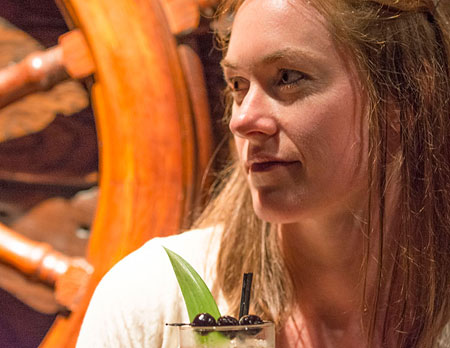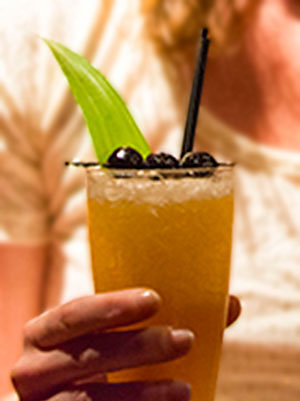Oral history project looks deep into cocktail culture
West Coast cocktail culture has a rich social history that's being revealed, and preserved, by the Cocktail Project, a new initiative of UC Berkeley’s Regional Oral History Office at the Bancroft Library.

July 8, 2014
California’s famous tiki bars of the 1930s and ‘40s traded on Polynesian enticements, and many of the bartenders mixing the magical Mai Tais were Asian. But chances are the bartenders were never seen by the customers. Racism kept them hidden away in the kitchen; white servers would take drink orders and transmit them through a walkie talkie concealed in a potted fern.
This is one of the many fascinating and fairly unknown strands of West Coast social history that’s being revealed — and preserved — by the Cocktail Project, a new initiative of UC Berkeley’s Regional Oral History Office at the Bancroft Library.

Oral historian Shanna Farrell has a taste for tiki bars and cocktail culture. Tiki bars, she says, are places where escapism mixes with important splashes of California history. (UC Berkeley photos by Hulda Nelson)
Here’s another, according to Shanna Farrell, the ROHO oral historian who heads up the project: As recently as the early 1970s, it was illegal for a woman to tend bar in California unless she was the owner’s wife or daughter. And it took a state Supreme Court ruling to change the law.
“When you study cocktails, you’re never just talking about spirits,” says Farrell, who is a cocktail aficionado and deft bartender, too. “It’s really a window into social history and labor history and economic history and gender and ethnicity. There are windows to so many things through the glass.”
West Coast Cocktails: An Oral History (the project’s formal title) is an ambitious effort to capture the nuances of West Coast cocktail culture right up through its modern-day renaissance, in the words of the people who have poured the drinks, made the spirits, driven the trends, been there to see it for themselves.
The Bancroft Library has proven a rich source of material, Farrell says, with everything from libations lore in books dating back to the 1800s in the Doe to current editions of Lucky Peach magazine in the Morrison Library.
With four pilot interviews already recorded, crowd-funding is under way to underwrite interviews with five key voices who link cocktails’ colorful past to their sophisticated present. Cocktails aren’t a traditional academic subject, so the project is depending on funding from outside the typical grant structure.
“Oral history, though, is a way to get at things that aren’t in the dominant historical record,” says Farrell. “We’re getting at things that are really important but aren’t otherwise documented.”
Cocktail research reveals aspects of everyday American life that often don’t get written down in the history books — but prove deeply engaging because people can relate to them, she adds. “We want people to be able to find a way into what we’re doing.”
Among those on tap to be interviewed for the project are Julio Bermejo, whose father, Tommy Bermejo, put tequila on the California cocktail map at his Tommy’s Mexican Restaurant in San Francisco. Another is Mike Buhen, who grew up in Los Angeles’ tiki culture — his father was legendary Don the Beachcomber bartender Ray Buhen — and has run Tiki Ti there for years.

Three Dots and a Dash, a fruit-topped rum cocktail made at Smuggler’s Cove, a San Francisco tiki bar.
Also in the queue are Thad Vogler, the influential bartender (Slanted Door) and now owner (Bar Agricole and Tru Normand) who changed the way the West Coast drinks with his use of fresh local, seasonal and house-made ingredients in his drinks; Jorg Rupf, founder of both Alameda’s St. George Spirits and the American artisan distillation movement the company embodies; and Seattle bartender Murray Stenson, who has built an international reputation as part of the West Coast cocktail scene for some 40 years.
Bartending in Brooklyn helped Farrell pay her way through college and graduate school in New York, and the experience opened her eyes to a culture that’s everywhere in America but, until its recent rehabilitation, has been seen as a negative in a society still in recovery from Prohibition.
“Wine is privileged; it’s classy. Beer is approaching this level too, with microbreweries and craft brewing,” says Farrell. “Spirits get a bad rap.”
Moving to the Bay Area, Farrell found a cocktail culture very different from New York’s. Back there, she says, cocktails were made precisely, according to classic recipes and unalterable proportions. Out here, drinks were much freer.
Farrell arrived in 2013 amid the flourishing of the “garden to glass” movement — which saw bartenders shopping for seasonal, local flavors alongside chefs, and the advent of house-made syrups, tonics and an asparagus spear in every glass. The movement is now national, a function of both food trends and the recognition by chains like Applebee’s that there’s a lucrative market for sophisticated cocktails.
The result has been the elevation of cocktail cultures, Farrell says, and the Cocktail Project will document the trend.
Social aspects of the culture are among the most powerful stories embedded in the material. For example, an article Farrell wrote for PUNCH magazine earlier this year starts with the provocative question: What does it mean to drink like a woman?
It’s a subject with a rich history, and the question has many answers. In her article, Farrell untangles a few of the threads woven into stereotypes of women and drinking, from Emily Post’s rules for women in bars to the invention of the Cosmopolitan to appeal to women’s “dainty” palates.
The Cocktail Project will explore more of them in interviews with influential Bay Area women bartenders, among others, including Jennifer Colliau of Berkeley’s Small Hand Foods, who helped detonate the current cocktail phenomenon from behind the bar at San Francisco’s Slanted Door restaurant; Claire Sprouse, a cocktail wunderkind, bartender and drinks consultant; and Rhachel Shaw, bartender at Hog Island Oyster Co. who is known for creating community in the bartending world.
Tiki culture — now also in comeback mode — holds a special fascination for Farrell, and adds unique dimensions to West Coast cocktail culture. It started with a surplus of rum in West Coast port cities because of World War II, Farrell says, and rose with its promise of exotic escape. It’s also one of the strongest intersections of all the social and cultural themes underlying cocktails, West Coast style, Farrell says, and the tales of the immigrant bartenders are just part of that.
The Cocktail Project, which is raising funds with an indiegogo online campaign through this week, is one way that ROHO is seeking to reinvigorate its Food and Wine subject area, which features interviews with many of the pioneers in the field but neglects spirits. Farrell hopes to follow up with a parallel project on West Coast coffee.
As with all ROHO projects, the interviews will be posted online. Anyone can listen to them — perhaps with a cocktail in hand.